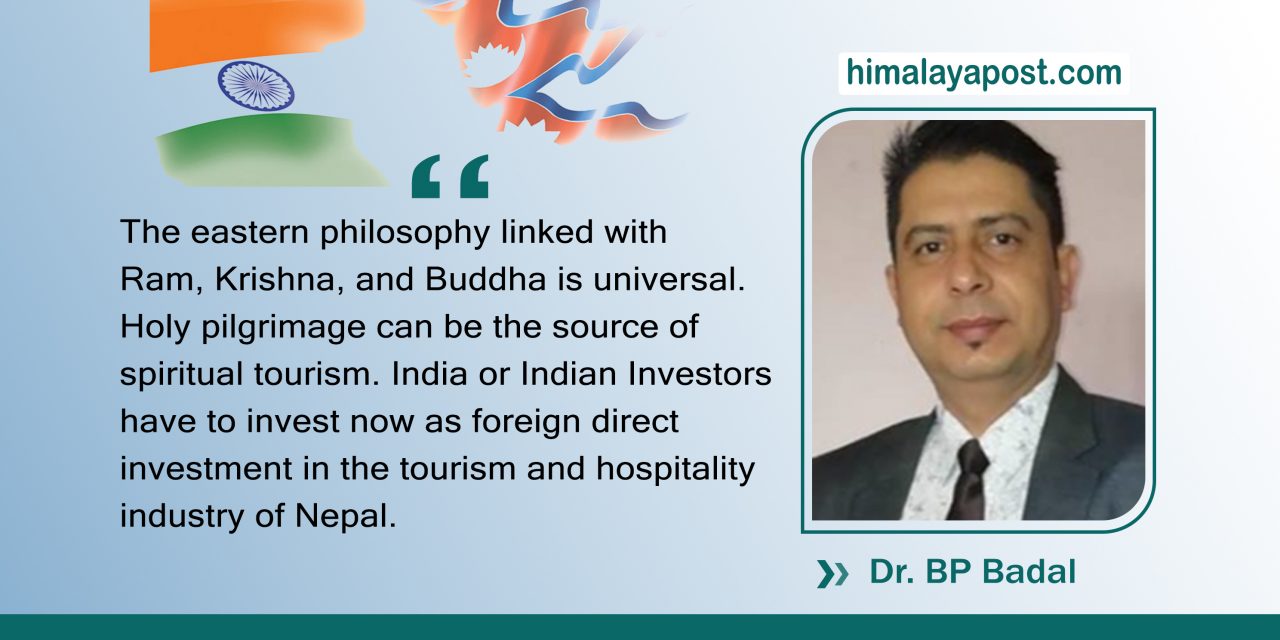– BP BADAL
Cultural tourism is the exploration and presentation of live rituals, festivals, ceremonies, and social relations based on truths and history. The root of truth and history are Dharma. Culture is the product of religion. 82 % Hindu and 11% Buddhist, altogether 93% people of Nepal belong to the Omkar community. But unfortunately, Nepal became secular in 2015. The government is secular but people are not. 93% of people are unhappy but the impact of modern imperialism to destroy the local culture is leading. Leaders are following the outdated mindset of modernity in the postmodern age. On the other hand, India is returning back to originality under the leadership of Modi. Although there are some burning issues in cultural relations. Regarding Lumbini – Birth place of Buddha, Oli’s Ayodhya, Madhesi Nationality, Remarkably Slow Development, and Lipu Lekh Kalapani, Nepal and India must be serious. Cultural tourism relation can enhance tract two diplomacy.
Lumbini – Birth place of Buddha
Tourists visit Lumbini. Ram was born in Ayodhya, Sita was born in Janakpur, Krishna was born in Mathura, and Buddha was born in Lumbini. It is an era of acting locally but thinking globally. The eastern philosophy linked with Ram, Krishna, and Buddha is universal. They are in Nepal and India; both countries have great respect for each other.
The philosophy of Buddhism or Hinduism, should not be limited to the national political boundary of India or Nepal. No one can divide the ownership of God. God could not be Indian or Nepali. God is universal. Buddha is the emblem of the real incarnation of global peace. Buddha was born in Nepal, so Buddha is Nepali.
Truly, Buddha is universal. Buddhism is the notion of four virtues of universal truth: Maitri, Karuna, Mudita, and Upekkhya. Buddhism is based on: Maitri (Friendship), Karuna (Kindness), Mudita (Joy), and Upekhya (Indifferences). Buddhism is the gift to the world from Nepal and India. The allegation of each other without getting the real essence of Buddhism has created certain problems on both sides. The Himavatkhanda (Kasmir to Kamakhya, Kailas to Ganga) is culturally Nepal.
The nations cannot teach Buddhism directly in schools. There is (Dukkha) Sorrow in life. Of course, there are causes of sorrows (Samudaya), but the sorrows can be managed or controlled (Nirodh). To get rid of this sorrow there is a fantastic spiritual way (Marga). The special path is a noble eightfold path based on Pragya, Sila, and Samadhi. Buddhism is a practical life science but we are not teaching. The value of eastern philosophy can be figured out only by the study of Buddhism, and it is possible only through visiting the four places according to Buddha. The four holy places are Lumbini, (the birthplace of Buddha, Nepal); Bodhgaya (the place of Buddha’s enlightenment), Sarnath (where Buddha delivered his first sermon), and Kushinagar (where Buddha took his nirvana). The Buddhist circuit is working however it needs more flexibility for young school students. In secular nation like Nepal and India, such a holy pilgrimage can be the source of spiritual tourism.
Oli’s Ayodhya
Themba Linus Dlamini tells in his harrowing story, that “Politics is a dirty game”. Even good politicians play bad roles in elections. Former prime minister Oli’s Ayodhya, as a communist, to attract Hindu Nationalists’ votes in Nepal, is propaganda only. He had offered a Golden Jhula in Pasupatinatha, and organized Ram Puja in the Prime minister’s official residence. His ancestors were Kumai Brhaman of Kumau India. The move hurt many Hindus and it became self-hurting to his political career. He is an intelligent Hindu Communist of Nepal. According to his close media in Nepal, it was the response to the Indian undeclared block in 2015.
According to different Shastras, in a lifetime a Hindu must visit four Dhams (Yamunottari, Gagottari, Badrinath, and Kedarnath in India) and Pashupatinath in Nepal. Similarly, a Vaishnav Hindu has to travel Ayodhya, Puri, Mathura, Vrindavan, Janakpur, and Rameshwaram to realize the meaning of existence. It is almost impossible to visit all sacred sites to middle-class families, so different rulers have developed such a temple everywhere in India and Nepal. Kathmandu is the city of Temple almost on every corner we can see a temple. Whoever for different reasons cannot visit such Dhams visit local like such Dhams. The history, philosophy, art, and culture of Ayodhya of Delhi are resembling in Oli’s Ayodhya. It is simply a construction of Ram’s temple in Nepal. The value of the Philosophy of Ramgita is increasing. However, Oli is a very clever politician. It is simply a notion of religious tourism.
Madhesi Nationality
Tourists love to visit Janakpur- the kingdom of Mithi- the origin of Maithil civilization. Visitors want to learn the philosophy of Mata Sita and King Janak. But how came Madhes in Mithila? The most contentious issue is Madhes. The diplomats and prominent political leaders of both countries completely failed to figure out the meaning of the Madhes. There was not any land, history, culture, or society of Madhes in Nepal before 2015. As being open boarder, Indian people from UP and Bihar used to visit Nepal as general workers and vendors. They were not Deshi (Inland) but Madhesi(Outland) for the entire Nepali people even in Terai. “Madhesi” the name was given other than Madhesi, as Indian name is given by outsiders according to Sadhguru instead of Hindustan or Bharat.
Most of the Madhesi leaders are newly migrated from India. They are actual Madhesi. The ignorance of, the philosophy of Janak, and the original civilization of Mithila are matters of dispute. They carry the Nehruvian political ideology of 1980, speak the Hindi language, use the Indian National flag as their political party’s flag, and select the election symbol of the Congress (I) party. They present themselves as the representatives of India and bargain for power showing the power of India. Few leaders from Yadav, Koiri, Mahato, Singh and so forth cast are guided and trained in Indian Congress and generated a fake Madhesi Nationality. They were able to cheat the Modi administration in India and threaten Nepal. Indian soft nature to help political groups in Nepal have created instability problem in Nepal. Indian support for Madhesi (new Migrants) was a problem for old migrants. Entire Aryans migrated from India to Nepal at the time of the Mughal as the Mongols migrated from the North.
Historically, when the Nepali congress was weak in 1990 India helped them, and they came to power. Then the communists were weak in 1995, and India helped them and they came to power. Similarly, Maoists were in the insurgency, India helped them in 2004, to dethrone the monarchy also India helped in 2006. The Indian moral support-help or giving the time to meet such group was the problem.
“India must help Nepal in its infrastructure development rather than support the immature political parties against the stability that has created instability”.
So to revive the Mithila civilization (Art, Language, Philosophy, and Cutler) the cultural tourism relation is most.
Slow Development
Tourists visit to see development not poverty. Indian Institute of Technology Roorkee (IIT Roorkee) provided scholarships for 30 engineers, to develop the upper Karnali Hydropower Project in 1975. All these engineers are retired now and some of them died too. But still the project is ongoing, and no one knows when will it be finished. It is frustrating. Development must be on time as everything needs at its time. People need everything in fast. Indian service delivery in infrastructure development is considered very slow. Nepal wants a train link from Delhi and Beijing as soon as possible. It is more difficult to develop the link in Beijing than in India. When on which date, the Indian train arrives in Kathmandu? When Arun 3 begins to deliver the electricity? As India wants, all these projects like the Motihari Amlekhgunj petroleum pipeline can be completed in time. India is Nepal’s first largest donner country for many years, China is in the second position, and others. As justice delayed is justice denied same development delayed is development denied. Every year India passes a considerable amount of budget for Nepal from parliament. But its implementation is questionable.
India or Indian Investors have to invest now as foreign direct investment in the tourism and hospitality industry. Nepal is going to invest massively in tourism infrastructure, even in hydropower dam sites she is developing five-star hotels targeting Indian and Chinese middle-class tourists.
Lipu Lekh and Kalapani
Nepal is tiny but beautiful nation in between big giant nations- India and China. Nepal is geographically small, economically poor, and weak in military defence. In such a situation, Nepal has the challenge to protect its sovereignty. No one knows who (China or India) will be furious and when. Nepal needs help from China against India and India against China. India and China both countries must understand the geopolitics of Nepal. It is more than 20 years since the DPR of Pancheshwar was not yet prepared. Nepal wants amendments of 83 year’s old Nepal India treaty of 1950 but India is reluctant. The eighth edition of the Indian national map is the problem of Lipulekh and Kalapani. Dialogue less situation in diplomacy is not the solution. The report prepared by the Nepal-India Eminent Persons Group (EPG), regarding the bilateral issues and amendments of the 1950 Treaty of Peace and Friendship between India and Nepal must be respected and cordially accepted by both nations as soon as possible.
Shreemadbhagavadgeeta was the result of the confusion of Arjuna on the battlefield of Kurukshetra. The confusion of Arjuna created the world’s best scripture. Thus, India and Nepal, have to develop a new cultural dimension of tourism diplomacy based on the common philosophical diaspora. The beauty of Nepal is the source of cultural tourism can be flourished through the admiring track two tourism diplomacy.
Dr. Badal ([email protected]) is a practicing scholar on rural tourism development and planning





